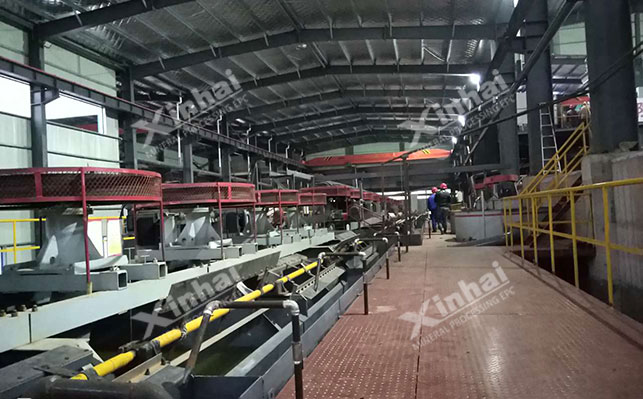
15311826613
Click to add WeChatFeldspar is a common aluminum silicate mineral, widely used in ceramics, glass and other industries. Its mineral composition is mainly composed of potassium, sodium, calcium and other elements. The mineral composition is relatively complex. In addition to feldspar minerals, it is often accompanied by impurities such as quartz, mica, and iron minerals. Feldspar flotation is one of the important means to achieve effective separation of feldspar from other minerals. Among them, activation conditions play a vital role in the effect of feldspar flotation. Let's take a look at what activation conditions are?
At present, the flotation method of feldspar ore is mainly based on cationic collector flotation and anionic collector flotation. The former uses the negative charge of cationic collectors on the surface of feldspar minerals to make the surface of feldspar minerals hydrophobic, thereby achieving the separation of feldspar from other minerals; the latter uses the metal ions on the surface of feldspar minerals by anionic collectors to make the surface of feldspar minerals hydrophobic, thereby achieving the separation of feldspar from other minerals.

Activation is an important step in the flotation process of feldspar. The purpose of activation is to increase the activity of the surface of feldspar minerals, enhance the effect of collectors and feldspar minerals, and thus improve the flotation recovery rate and grade of feldspar.
Due to the complex surface properties of feldspar ore, there is often an oxide film or some impurity ions adsorbed. These factors will reduce the activity of the surface of feldspar minerals and affect the adsorption of collectors. Therefore, an activator needs to be added for activation to accelerate the adsorption rate of collectors on the surface of feldspar minerals. In addition, sometimes due to the limited selectivity of collectors for feldspar minerals, activation is also required to improve the specific effect of collectors and feldspar minerals.
During the flotation of feldspar ore, the hydrophilicity of the feldspar surface is enhanced by activators, and different types of activators have different activation effects on specific minerals. In order to achieve efficient feldspar flotation activation, the following aspects need to be considered:

Acid activators: Commonly used acid activators are sulfuric acid, hydrochloric acid, hydrofluoric acid, etc. These acids can dissolve the oxide film and impurities on the surface of feldspar minerals and improve the activity of the surface of feldspar minerals. However, the use of acid activators needs to pay attention to controlling the dosage and pH value to avoid corrosion to equipment and pollution to the environment.
Metal ion activator: Commonly used metal ion activators include iron ions, aluminum ions, calcium ions, etc. These metal ions can form complexes with anions on the surface of feldspar minerals to enhance the hydrophobicity of the surface of feldspar minerals. The selection of metal ion activators needs to be determined according to the composition of feldspar minerals and flotation process.
Organic activators: Commonly used organic activators include oxalic acid, tartaric acid, citric acid, etc. These organic activators can form complexes with metal ions on the surface of feldspar minerals to improve the activity of the surface of feldspar minerals. The use of organic activators is relatively safe and has less pollution to the environment.
The dosage of activator needs to be determined according to the properties of feldspar minerals, flotation process and type of activator. Generally speaking, too little activator can not achieve the activation effect; too much activator may lead to over-activation, which will reduce the flotation effect of feldspar. In actual production, the appropriate amount of activator can be determined through mineral processing experiments.
The pH value of ore pulp has a great influence on the activation effect of feldspar flotation. Different activators show different activation effects at different pH values. Generally speaking, acid activators work better under acidic conditions, while metal ion activators and organic activators work better under weakly acidic or neutral conditions. In actual production, it is necessary to determine a reasonable ore pulp pH value according to the type of activator and the properties of feldspar minerals.
Temperature and stirring intensity will also affect the activation effect of feldspar flotation. Generally speaking, appropriately increasing the temperature and stirring intensity can accelerate the adsorption rate of the activator on the surface of the feldspar mineral and improve the activation effect. However, too high temperature and too high stirring intensity may also cause the decomposition of the activator and the crushing of the feldspar mineral, reducing the activation effect. In actual production, it is necessary to determine a reasonable temperature and stirring intensity according to the type of activator and the properties of the feldspar mineral.
The above are the requirements for activation during flotation of feldspar. In actual production, the activation conditions for feldspar flotation are a complex issue, which requires comprehensive consideration of multiple factors such as the properties of feldspar minerals, flotation process, and type of activator. By reasonably selecting activators, controlling the amount of activators, adjusting the pH value of the slurry, controlling temperature and stirring intensity, etc., the flotation effect of feldspar can be significantly improved, and effective separation of feldspar from other minerals can be achieved.